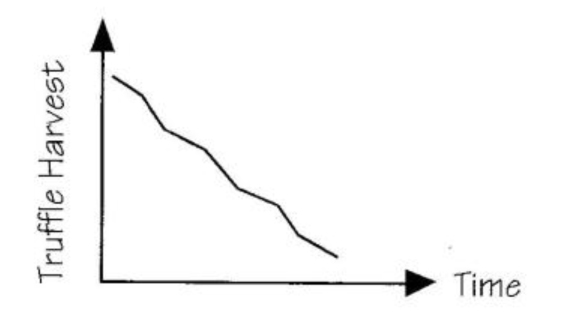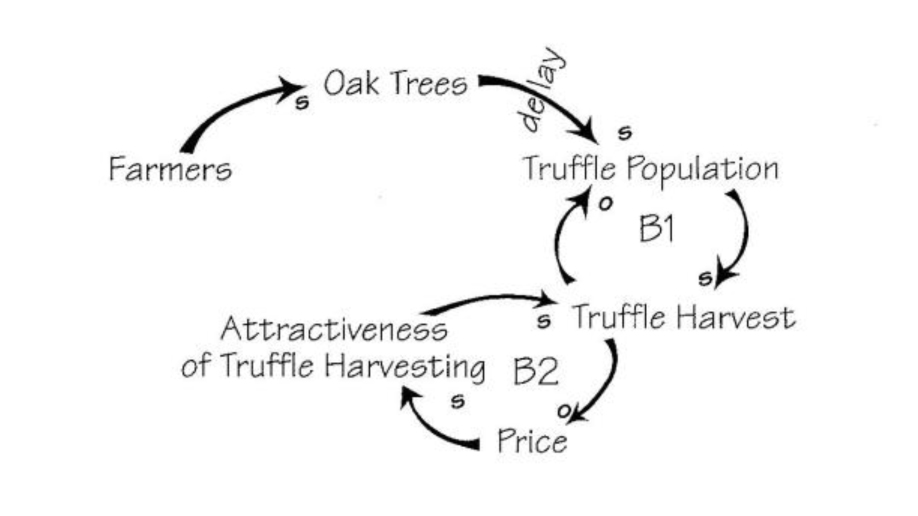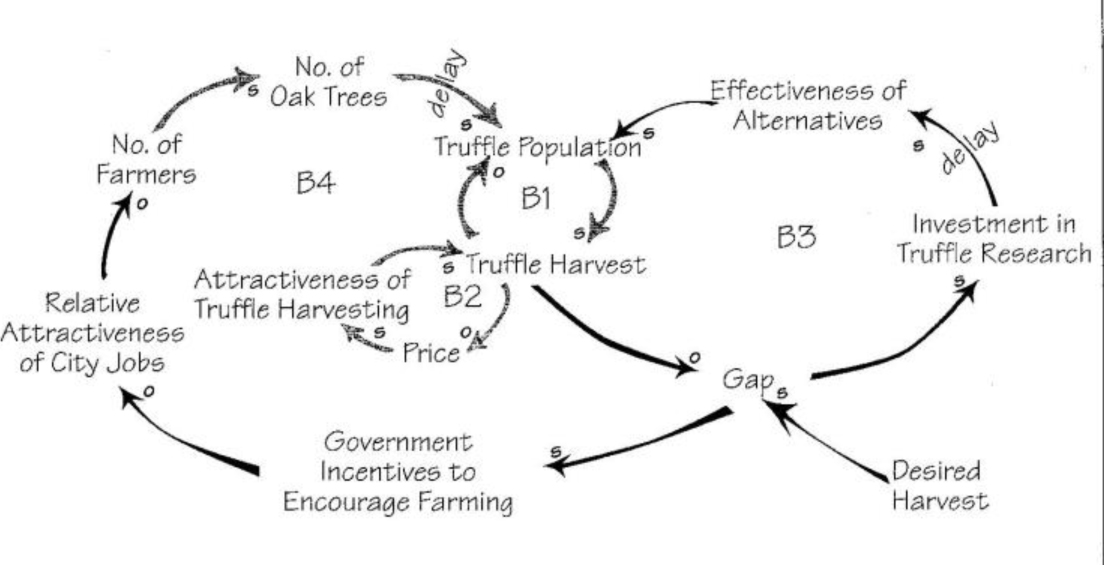Peasants in southwest France have been selling smelly but delicious black truffles to restaurants for more than $600 a kilo (2.2 lb). Not surprisingly, then, they are worried by signs that their lucrative fungus may be dying out. At the turn of the century, more than 1,000 tonnes of French truffles were sniffed out by pigs and scraped up every year. Now barely an annual lorryload is filled.
It is the farmers’ fault. . . . They have neglected to plant new oaks. It takes ten years for truffles to appear under them in edible size. Truffles have dwindled. The price, in 30 years, has tripled. . . . Now the French taxpayer is paying for research into just how the truffle is born.”
–Ruffling France’s Truffles,’ The Economist, May 4, 1996
France’s Truffle Crisis
Why should anyone other than gourmets care about the fate of the black truffle? French government officials are concerned because the declining truffle harvest is opening the way for foreign competition. Though France dismisses the truffles grown by other countries as being of “dreadfully inferior quality,” some restaurateurs say that you cannot tell the difference—which could mean a big difference in terms of France’s hold on the worldwide truffle market.
But systems thinkers can also find something of interest in France’s “truffle crisis.” The issue—complete with long time delays and interesting behavior over time—lends itself well to a systemic perspective, and can provide a good opportunity for practicing drawing casual theories of a problem. Since most news articles are event oriented, drawing causal diagrams of news stories provides excellent practice in moving from events to patterns over time to systemic structure.
Creating a Causal Theory
The first step in creating a causal theory is to identify the problem and map key behaviors over time. In this case, the Economist article described the “problem” as a declining truffle harvest and a tripling of the price of truffles over the last 30 years (see “Declining Truffle Harvest”).
We know from the article that the truffle harvest is dependent on the truffle population, which in turn is based on the number of appropriately aged oak trees under which the truffles grow. The dynamics suggested by the Economist is that farmers are planting fewer oak trees, leading to less nurturing oak trees, a fall in the truffle population, lower truffle harvest, and finally, climbing prices (see “Simple Explanation”).
We can expand on this rather linear worldview by looking for plausible feedback loops. For example, a simple balancing loop governs the relationship between population and harvest—increasing population allows for a greater harvest, but each year the harvest reduces the live population (B1 in “Closing Feedback Loops” on p. 8). Based on general commodities theory, as the price goes up, we would expect people to put more effort into gathering truffles, which would lead to an increase in the truffle harvest and an eventual decrease in the price (B2). Notice, however, that the two balancing loops could act as a reinforcing loop—the higher price leading to a greater harvest, potentially lowering the population beyond its ability to regenerate, which would lower the harvest and raise the price even further in the future.
Declining Truffle Harvest

The Economist article cites a decline in the truffle harvest over time.
Simple Explanation

The simple explanation offered by the Economist article is that farmers are planting fewer oak trees, leading to less nurturing oak trees, a fall in the truffle population lower truffle harvest, and finally, climbing prices.
Exploring Solutions
To close the gap between the actual truffle harvest and the desired truffle harvest, the French government is investing in research to find ways to increase the truffle harvest without relying on oak trees. The implicit thinking behind this strategy is that putting more money into research will (after a time delay) result in effective alternatives for increasing the truffle harvest, and thus reduce the price to reasonable levels (B3 in “Looking for ‘Solutions’ “).
Technological Solutions
Investing in research can be described as a technological solution—an attempt to solve a problem by developing alternatives that bypass the cause of the problem. This is often faster and cheaper than finding a more fundamental structural solution. Without a clear understanding of the root causes, however, this approach risks creating unintended consequences that could set off a cascade of additional problems.
While the Economist article focused on potential technological solutions that would bypass the need for oak trees, other solutions could also be found by examining why the oak tree population itself is declining, and what can be done about it. Traditionally, oak trees in France have been planted by farmers in the course of their normal farm maintenance. Since most farmers lived on their farm for life, the 10-year delay between planting and truffle harvest was negligible. Over the last century, however, more farmers have been seeking employment in the city, as the attractiveness of city jobs relative to working on the farm has increased.
The question this raises for the French government is whether the oak tree population can be increased without relying on the farmers, or whether the farmers can be encouraged to take up farming (and oak planting) again. Because of the 10-year time delay between planting an oak tree and harvesting the truffles, it would be difficult to rely on short-term market forces to encourage the planting of trees. Through public programs, the French government could (and actually is) encouraging children to plant trees—but this is not likely to be a sustainable long-term solution, because it will likely stop as soon as the government push ends.
Closing Feedback Loops

A simple balancing loop describes the relationship between population and harvest—increasing population allows for a greater harvest, but each year the harvest reduces the live population (BI). Similarly, as the price of truffles increases (due to shortages), the percent of the truffle population harvested would increase, thus increasing the harvest and lowering the price (B2).
Looking for “Solutions”

One possible solution is to invest money in alternative farming techniques which would increase the truffle population and keep prices in check (B3). Another alternative is to explore the social forces that are leading to a decline in oak tree planting (B4).
To ensure the long-term oak tree supply, the French government might therefore need to examine the forces that have made it so attractive to leave the farm for the city, and potentially create incentives to encourage more domestic farming (B4). Since the dynamics around this migration is complex and the delays long, it is not hard to imagine why the government is hoping for a technological solution rather than trying to influence a major social dynamic.
Using Articles for Practice
Using the truffle example, we have tried to illustrate how one might practice developing causal theories using stories found in magazine or newspaper articles. In summary, the process would be to:
1. Look for articles that talk about a problem over time. Avoid specific cases (Joe lost his job today) and hunt for trends (more and more people are losing their jobs).
2. Draw out the behavior over time. This provides a reference point of behavior that the causal theory should be able to explain.
3. Map out the problem as described in the article, first limiting yourself to the data directly mentioned. Then add other variables or feedback loops that you would hypothesize are driving forces behind the problem.
4. Map out any proposed solutions, and then look for unintended consequences or other alternatives.
Peter Senge has said, “We only learn what we want to learn.” By using real-life news items as the starting point for developing theories, the practice of systems thinking becomes more than an academic exercise. It can serve as a true exploration of issues that are important to us.
Linda Booth Sweeney is an educator consultant, and associate of the MR Center for Organizational Learning.
Don Seville is an associate with GKA Incorporated and is affiliated with Sustainable Solutions.
Editorial support for this article was provided by Colleen Lannon.
